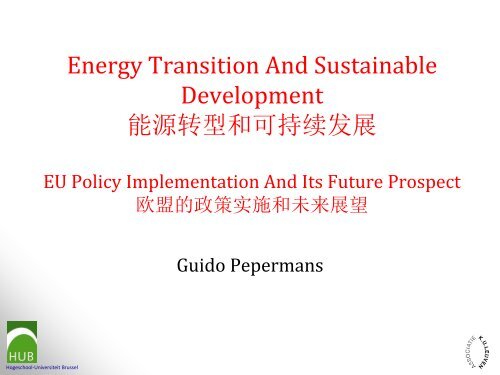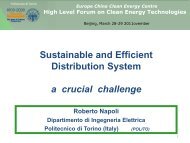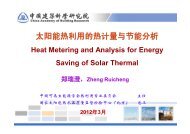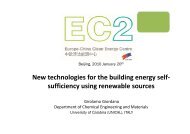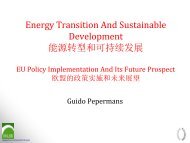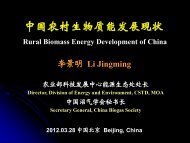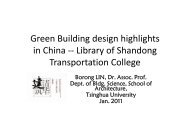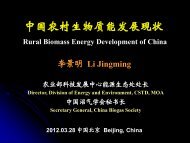能源转型和可持续发展 - Europe-China Clean Energy Centre
能源转型和可持续发展 - Europe-China Clean Energy Centre
能源转型和可持续发展 - Europe-China Clean Energy Centre
You also want an ePaper? Increase the reach of your titles
YUMPU automatically turns print PDFs into web optimized ePapers that Google loves.
Hogeschool-Universiteit Brussel<br />
<strong>Energy</strong> Transition And Sustainable<br />
Development<br />
<strong>能源转型和可持续发展</strong><br />
EU Policy Implementation And Its Future Prospect<br />
欧盟的政策实施和未来展望<br />
Guido Pepermans
Hogeschool-Universiteit Brussel<br />
Introduction 介绍<br />
EU <strong>Energy</strong> Roadmap 2050 欧盟2050能源路线图<br />
Long term plan adopted on December 15 th , 2011.<br />
2011年12月15日通过了长期计划<br />
Aim 目标<br />
Reduce greenhouse gas (GHG) emissions to 80-95% below those of<br />
1990 in the coming four decades<br />
未来四十年在1990年基础上减少80-95%的温室气体排放<br />
Current policy would only reach about 40% of the targeted<br />
emission reductions<br />
现有政策只能支持完成40%的减排目标<br />
Challenge 挑战<br />
Close the gap<br />
缩小差距<br />
While staying competitive and keeping a secure energy sector<br />
同时确保能源行业的竞争力和安全性
Hogeschool-Universiteit Brussel<br />
Introduction 介绍<br />
EU <strong>Energy</strong> Roadmap 2050 欧盟2050能源路线图<br />
Too ambitious? 太雄心勃勃?<br />
If plans aren’t made or postponed, the cost will be much<br />
higher<br />
不制定计划或计划推迟将导致更高的成本<br />
Roadmap explores different routes and alternatives<br />
towards decarbonisation<br />
路线图探索了实现脱碳的不同路径和可选方案<br />
Outcome 结果<br />
Identify ‘no regret’ options 确定“无悔”选择<br />
Need to work together 需要共同努力<br />
10 structural changes 10个结构性变化
Hogeschool-Universiteit Brussel<br />
Structure Of The Presentation<br />
演讲内容大纲<br />
EU Policy on <strong>Clean</strong> <strong>Energy</strong>: An Overview<br />
欧盟清洁能源政策:概述<br />
The EU roadmap 2050 and the <strong>Europe</strong>an <strong>Energy</strong> system<br />
欧盟2050路线图和欧洲能源体系<br />
How to implement the energy roadmap?<br />
如何实施能源路线图?<br />
What are the challenges and the opportunities?<br />
有哪些挑战和机遇?<br />
<strong>Energy</strong> transition at the country level: Some Case studies<br />
国家层面的能源转型:一些案例<br />
The United Kingdom (UK) and Germany<br />
英国和德国
Hogeschool-Universiteit Brussel<br />
EU <strong>Energy</strong> Policy 欧盟能源政策<br />
The Actors 相关方<br />
EU Commission 欧盟委员会<br />
Right to initiate legislation → Considerable impact on the agenda<br />
有权提出立法→对日程有相当大的影响力<br />
Has no decisive say 没有决定性发言权<br />
Can be mandated by the EU Council to prepare <strong>Energy</strong><br />
legislation 可由欧盟理事会授权准备能源立法<br />
EU Council 欧盟理事会<br />
Respective ministers (of <strong>Energy</strong>) of the MS 成员国各自的(能<br />
源)部长<br />
Strong focus on Member State (MS) interests 强烈关注成员国的兴趣<br />
Past: unanimous decision was needed 过去:需全票通过<br />
Lisbon Treaty → Qualified majority is sufficient 里斯本条约→ 特<br />
定多数通过原则
EU <strong>Energy</strong> Policy 欧盟能源政策<br />
The Actors 相关方<br />
EU Parliament 欧盟议会<br />
Lisbon treaty gives more power: simple majority is sufficient 里斯本条<br />
约授予其更多权利:简单多数通过原则<br />
Member States (MS) 成员国<br />
<strong>Energy</strong> ministers and heads of state determine general direction of<br />
<strong>Energy</strong> policy 能源部长和国家元首确定能源政策大方向<br />
EU can only act when given the competence to do so by the MS 只有成<br />
员国授权后欧盟才能执行<br />
Not always in short term interest of MS to do so 并不总是根据成员国的短<br />
期利益采取行动<br />
<strong>Energy</strong> mix is MS competence 能源结构是成员国的竞争力<br />
(Inter-)national energy companies 国际/国家能源公司<br />
Via Associations and lobby groups 通过协会和游说团体<br />
National champions have influence via national politics 国家领军企业<br />
可以通过国家政治产生影响<br />
Are needed to invest in infrastructure → Important players! 需要投资<br />
基础设施建设→ 是重要参与者!<br />
Hogeschool-Universiteit Brussel
Hogeschool-Universiteit Brussel<br />
EU <strong>Energy</strong> Policy 欧盟能源政策<br />
A Timeline 时间表<br />
1960s: focus on the national level 着眼国家层面<br />
1970s: oil crises triggered push towards cooperation 石油危机引发<br />
对合作的促进<br />
Guidelines concerning energy supply and energy demand 关于能源供需的<br />
指导<br />
Among others, the promotion of nuclear 其中,促进核能<br />
1980s: environmental protection was included into the Single<br />
<strong>Europe</strong>an act 环境保护被纳入欧洲统一法案<br />
Up to then, energy legislation was mostly driven by economic factors 截至<br />
此时,经济是环境立法的主要推动因素<br />
1990s: Environmental protection became prominent driver of<br />
energy policy 环境保护成为能源政策的主要驱动因素<br />
Intergovernmental Panel on Climate Change (IPCC) assessment reports (1990…)<br />
IPCC评估报告(1990…)<br />
Earth summit in Rio (1992) 里约地球峰会<br />
Kyoto protocol (1997) 《京都议定书》<br />
Increased awareness of the importance of EU coordinated action 更多认识<br />
到欧盟层面共同行动的重要性
2000s:<br />
Hogeschool-Universiteit Brussel<br />
EU <strong>Energy</strong> Policy 欧盟能源政策<br />
A Timeline 时间表<br />
EU Renewables directive (2001 and 2003) 欧盟可再生能源指令<br />
Emission trading (2005) 排放交易<br />
EU <strong>Energy</strong> action plan (January 2007) 欧盟能源行动计划(2007年1<br />
月)<br />
Start of an integrated <strong>Europe</strong>an energy policy 开始统一的欧盟能源政策<br />
Third package (September 2007) 第三个一揽子(2007年9月)<br />
Complete the integration of the EU Electricity and Gas Markets 完成欧盟电力<br />
和天然气市场一体化<br />
Strategic <strong>Energy</strong> Technology (November 2007) 战略能源技术(2007<br />
年 11月 )<br />
Set priorities for future energy technologies 为未来能源技术制定了优选次序<br />
<strong>Energy</strong> and Climate package (January 2008) 能源和气候一揽子<br />
(2008年1月)<br />
<strong>Europe</strong>an <strong>Energy</strong> Programme for Recovery (July 2009) 欧洲能源振兴<br />
计划(2009年7月)<br />
Legally binding framework for nuclear safety (June 2009) 具有法律约<br />
束力的核安全框架(2009年6月)
Hogeschool-Universiteit Brussel<br />
EU <strong>Energy</strong> Policy 欧盟能源政策<br />
A Timeline 时间表<br />
The EU <strong>Energy</strong> Action Plan 欧盟能源行动计划<br />
Identifies 3 major challenges → Core of EU policy today 提出三个主要<br />
挑战→现在欧盟政策的核心<br />
Sustainability 可持续发展<br />
Security of Supply 供应安全<br />
Competitiveness 竞争力<br />
Working areas are identified 工作领域<br />
Completion of the internal market 完成内部市场<br />
Issues concerning security of supply 供应安全相关问题<br />
Internal energy policies 内部能源政策<br />
Technology 技术<br />
The Council invited the Commission to propose regulation in these<br />
areas 欧盟理事会邀请欧盟委员会制定这些领域的相关政策<br />
EU Directives on Emission Trading (2008), The promotion of renewable<br />
energies (2008), Carbon Capture and Storage (2008) 欧盟排放交易指令<br />
(2008),促进可再生能源(2008),碳捕获和储存(2008)
Hogeschool-Universiteit Brussel<br />
EU <strong>Energy</strong> Policy 欧盟能源政策<br />
A Timeline 时间表<br />
<strong>Energy</strong> and Climate package 能源和气候一揽子<br />
Sets quantifiable targets → the ‘20/20/20 targets’<br />
制定量化目标→ “20/20/20目标”<br />
Reduction of GHG emissions to 20% below 1990 levels<br />
在1990年基础上减少20%的温室气体排放<br />
20% of energy consumption covered by renewable sources<br />
可再生能源占能耗的20%<br />
20% reduction in primary energy use compared to projected level<br />
(energy efficiency)<br />
和预测水平相比减少20%的一次能源消费(能源效率)
Hogeschool-Universiteit Brussel<br />
EU <strong>Energy</strong> Policy 欧盟能源政策<br />
A Timeline 时间表<br />
The <strong>Energy</strong> Action Plan was complemented by changes in EU<br />
legislation → The Lisbon Treaty 欧盟立法的修改完善了能源<br />
行动计划→里斯本条约<br />
Includes a title on energy, with emphasis on 包括一项关于能源的标题,<br />
其中重点关注<br />
The functioning of the internal market 内部市场运作<br />
Ensuring security of supply 确保供应安全<br />
Promoting energy efficiency and energy savings 促进提高能效和节能<br />
Developing and promote new and renewable forms of energy 发展和促进<br />
新能源和可再生能源<br />
Promoting the interconnection of energy networks 促进能源网络之间的<br />
相互联系<br />
Decisions on legislative proposals are made via the ordinary legislative<br />
procedure 通过普通立法程序决定立法建议<br />
Measures of a primarily fiscal nature require unanimity in the Council<br />
主要的财政性质的措施需要得到欧盟理事会的一致通过
EU <strong>Energy</strong> Policy 欧盟能源政策<br />
Current Developments & Future Challenges 目前进展和未来挑战<br />
Two important strategy papers 两项重要的战略报告<br />
1. ‘<strong>Energy</strong> 2020. A strategy for competitive, sustainable and<br />
secure energy’ (2010) “能源2020--有竞争力的、可持续的和<br />
安全的能源战略”(2010)<br />
2. ‘<strong>Energy</strong> Roadmap 2050’ (December 2011) “2050能源路线图”<br />
(2011年12月)<br />
The ‘<strong>Energy</strong> 2020’ strategy paper<br />
“能源2020”战略文章<br />
Builds upon the EU <strong>Energy</strong> Action Plan<br />
在欧盟能源行动计划的基础上建立<br />
Aims at providing new tools that should allow to achieve the 2020<br />
targets and the targets set in the longer term<br />
旨在提供新的工具以实现2020年目标和更长期的目标<br />
Emphasizes the urgent need to act in order to reach the<br />
climate targets but also to stay competitive 强调迫切需要采取<br />
行动以实现气候目标,但同时也要保持竞争力<br />
Hogeschool-Universiteit Brussel
EU <strong>Energy</strong> Policy 欧盟能源政策<br />
Facts & Figures – World <strong>Energy</strong> Demand 事实&数据—世界能源需求<br />
Hogeschool-Universiteit Brussel<br />
世界能源需求不断增长<br />
世界能源需求<br />
世界其他<br />
中国<br />
其他OECD<br />
欧盟
Hogeschool-Universiteit Brussel<br />
EU <strong>Energy</strong> Policy 欧盟能源政策<br />
Facts & Figures – EU <strong>Energy</strong> Import Dependency<br />
事实&数据—欧盟能源进口依存度<br />
欧盟27国能源进口依存度
Hogeschool-Universiteit Brussel<br />
EU <strong>Energy</strong> Policy 欧盟能源政策<br />
Facts & Figures – EU <strong>Energy</strong> Import Dependency by Country<br />
事实&数据—欧盟各国能源进口依存度<br />
2009年欧盟成员国能源进口依存度
Hogeschool-Universiteit Brussel<br />
EU <strong>Energy</strong> Policy 欧盟能源政策<br />
Facts & Figures – EU <strong>Energy</strong> Consumption by Fuel<br />
事实&数据—欧盟能源消费(按燃料)<br />
煤 油 气 核 可再生<br />
1990和2009年欧<br />
盟内陆能源消费<br />
总量(按燃料分)<br />
内陆能源消费总量<br />
(Mtoe)
Hogeschool-Universiteit Brussel<br />
EU <strong>Energy</strong> Policy 欧盟能源政策<br />
Facts & Figures – EU <strong>Energy</strong> Consumption by Sector<br />
事实&数据—欧盟能源消费(按部门)<br />
不同部门终端能源消费(Mtoe)<br />
工业 交通 家庭 服务业
Hogeschool-Universiteit Brussel<br />
EU <strong>Energy</strong> Policy 欧盟能源政策<br />
Facts & Figures – EU <strong>Energy</strong> Mix in the Electricity Market<br />
事实&数据 – 欧盟电力市场能源结构<br />
Production<br />
Capacity<br />
装机<br />
Gross Electricity<br />
Generation<br />
发电量
Hogeschool-Universiteit Brussel<br />
EU <strong>Energy</strong> Policy 欧盟能源政策<br />
Facts & Figures – EU <strong>Energy</strong> Mix in the Electricity Market<br />
事实&数据 – 欧盟电力市场能源结构<br />
1990和2009年欧盟发电量(按燃料分)
Hogeschool-Universiteit Brussel<br />
EU <strong>Energy</strong> Policy 欧盟能源政策<br />
Facts & Figures – Renewable <strong>Energy</strong> in the Electricity Market<br />
事实&数据 – 欧盟电力市场中的可再生能源<br />
欧盟27国可再生能源发电净装机容量
Hogeschool-Universiteit Brussel<br />
EU <strong>Energy</strong> Policy 欧盟能源政策<br />
Facts & Figures – <strong>Energy</strong> Mix in the Electricity Market<br />
事实&数据 – 欧盟电力市场能源结构<br />
2009年气电装机比例%<br />
2009年煤电(和其他化石燃料)装机比例%
Hogeschool-Universiteit Brussel<br />
EU <strong>Energy</strong> Policy 欧盟能源政策<br />
Facts & Figures – CO2 emissions by Sector<br />
事实&数据 – 不同部门CO2排放<br />
欧盟27国分行业CO2排放<br />
欧盟27国分行业CO2排放<br />
(比例,2007年数据)
Hogeschool-Universiteit Brussel<br />
EU <strong>Energy</strong> Policy 欧盟能源政策<br />
Facts & Figures – 20-20-20 Targets – CO2 emissions<br />
事实&数据 – 20-20-20目标 - CO2排放<br />
2009年分行业CO2排放<br />
2020年温室气体排放目标(和2005年水平相比)
Hogeschool-Universiteit Brussel<br />
EU <strong>Energy</strong> Policy 欧盟能源政策<br />
Facts & Figures – 20-20-20 Targets – Renewables<br />
事实&数据 – 20-20-20 目标 – 可再生能源<br />
可再生能源所占比例<br />
2005年水平<br />
实现2020年目标还需努力
Hogeschool-Universiteit Brussel<br />
EU <strong>Energy</strong> Policy 欧盟能源政策<br />
Facts & Figures – <strong>Energy</strong> Efficiency 事实&数据 – 能效<br />
20%能效目标 vs.<br />
部分EEAP能效政<br />
策截至2009年的预期<br />
成果(PRIMES模型<br />
预测结果)
EU <strong>Energy</strong> Roadmap 2050 欧盟2050能源路线图<br />
Introduction 介绍<br />
EU is committed to reduce GHG emissions to 80-95% below 1990 levels by<br />
2050 欧盟承诺2050年在1990年基础上减少80-95%的温室气体排放<br />
Hogeschool-Universiteit Brussel<br />
Pathway until 2020 is set in ‘<strong>Energy</strong> 2020 strategy paper’, but more is needed!<br />
“2020能源战略报告”中制定了2020年的减排路径,但还不够<br />
Continues to deliver after 2020 → 40% emission reduction by 2050<br />
2020年以后需要继续减排→2050年减排40%<br />
The ‘<strong>Energy</strong> Roadmap 2050’<br />
“2050能源路线图”<br />
Should give guidance for actions required after 2020<br />
应该就2020年后需要的行动提出指导<br />
Market based and technology neutral approach<br />
基于市场的和技术中立的手段<br />
Key question<br />
关键问题<br />
How to realize the decarbonisation objective while guaranteeing supply, security<br />
and competitiveness of the energy sector?<br />
如何在实现脱碳目标的同时保障能源供应、能源安全以及能源行业的竞争力?
EU <strong>Energy</strong> Roadmap 2050 欧盟2050能源路线图<br />
Introduction 介绍<br />
Why such a long term plan<br />
为什么制定如此长期的计划<br />
Hogeschool-Universiteit Brussel<br />
Not clear what should follow 2020 agenda → Uncertainty<br />
不清楚2020年后的日程→ 不确定性<br />
Necessary investments are postponed 必要的投资被推迟<br />
‘<strong>Energy</strong> Roadmap 2050’ explores the challenges posed to the EU power<br />
sector to achieve this target<br />
“2050能源路线图”探索了欧盟电力行业实现目标的挑战<br />
While ensuring security and competitiveness<br />
同时保证能源安全和竞争力<br />
Approach 方法<br />
Assess various scenarios with numerical model (PRIMES)<br />
利用PRIMES数据模型对不同情景进行评估<br />
No forecasts! 没有预测!<br />
Alternative routes are explored 探索了替代路径<br />
Scenario’s a are of illustrative nature 情景起到说明作用
EU <strong>Energy</strong> Roadmap 2050 欧盟2050能源路线图<br />
The PRIMES Model。 PRIMES模型<br />
Partial equilibrium model 局部均衡模型<br />
Hogeschool-Universiteit Brussel<br />
Developed early 1993-94 but continuously extended and updated<br />
1993-94年开发出来但不断扩展和更新<br />
Has been used for EU policy evaluation on many occasions<br />
已经在很多场合对欧盟政策进行评估<br />
Main model characteristics 模型主要特点<br />
All economic sectors are represented separately<br />
所有经济部门分开表示<br />
Micro-economic foundation, taking into account engineering<br />
constraints 微观经济基础,考虑工程约束<br />
Regions 区域<br />
EU-27, Western Balkans countries, the EFTA countries (Switzerland,<br />
Norway) and Turkey 欧盟27国、西巴尔干地区国家、欧洲自由贸易<br />
区国家(瑞士,挪威)和土耳其
EU <strong>Energy</strong> Roadmap 2050 欧盟2050能源路线图<br />
The PRIMES Model。 PRIMES模型<br />
Fuel types 燃料类型<br />
Hogeschool-Universiteit Brussel<br />
26 energy forms 26种能源形式<br />
Demand sectors 需求部门<br />
Residential, Services and agriculture, Industry, Transportation<br />
住宅、服务业、农业、工业、交通<br />
Supply sectors 供应部门<br />
Electricity and steam, Natural gas, Biomass supply, Refineries,<br />
Hydrogen, Primary fossil fuel production<br />
电力和蒸汽、天然气、生物质供应、炼油、 氢、一次化石燃料生产<br />
Time horizon 时间跨度<br />
2050 by periods of 5 years 到2050年,每5年一个阶段
EU <strong>Energy</strong> Roadmap 2050 欧盟2050能源路线图<br />
The PRIMES Model 。 PRIMES模型<br />
Hogeschool-Universiteit Brussel
EU <strong>Energy</strong> Roadmap 2050 欧盟2050能源路线图<br />
Introduction 介绍<br />
Scenarios explore combinations of 4 decarbonisation<br />
routes 不同情景探索了4种脱碳途径的结合<br />
Hogeschool-Universiteit Brussel<br />
<strong>Energy</strong> efficiency 提高能效<br />
Renewable energy resources 可再生能源资源<br />
Nuclear power 核能<br />
Carbon capture and storage 碳捕获和储存<br />
Modelling outcomes 模型结果<br />
Description of the consequences of carbon free energy<br />
system 无碳能源系统的结果描述<br />
Information allows MS to make required energy choices<br />
信息允许成员国选择需要的能源
EU <strong>Energy</strong> Roadmap 2050 欧盟2050能源路线图<br />
Introduction 介绍<br />
Outcomes 结果<br />
Hogeschool-Universiteit Brussel<br />
Simulations show clear trends, structural changes, challenges and<br />
opportunities 仿真结果显示了明确的趋势、结构变化和机遇<br />
Conclusions common to all or most of the scenarios 所有或绝大多数情景<br />
的结论基本一致<br />
Key conclusions on ‘no regret’ options 主要结论是“无悔”选择<br />
Focusing on common results might help to achieve a common<br />
<strong>Europe</strong>an approach 重点关注共同结果可能有助于实现统一<br />
的欧盟措施<br />
Conclusion 结论<br />
Decarbonised system in 2050 is possible at moderate cost 2050年脱碳<br />
系统在适当的成本下可行<br />
On the condition that a global climate deal is finalised 其中一个条件是全<br />
球达成最终的气候协议
EU <strong>Energy</strong> Roadmap 2050 欧盟2050能源路线图<br />
The Scenarios 情景<br />
Two current trend scenarios 2个现有趋势情景<br />
Hogeschool-Universiteit Brussel<br />
1. Business as usual 趋势照常<br />
2. Current Policy Initiatives 现有政策措施<br />
Five complete decarbonisation scenarios 5个完全脱<br />
碳情景<br />
Combinations of the 4 decarbonisation routes 4个脱碳路径的不同<br />
组合<br />
1. High <strong>Energy</strong> Efficiency 高能效<br />
2. Diversified Supply Technologies 供应技术多样化<br />
3. High Renewable <strong>Energy</strong> Resources 可再生能源大量利用<br />
4. Delayed CCS 推迟CCS<br />
5. Low Nuclear 低核能
EU <strong>Energy</strong> Roadmap 2050 欧盟2050能源路线图<br />
Scenario 1 - Business As Usual 情景1 – 趋势照常<br />
A common reference scenario, also used in<br />
一个常见的参考情景,同时也用于:<br />
Hogeschool-Universiteit Brussel<br />
Low Carbon Economy Roadmap 低碳经济路线图<br />
Transport White Paper 交通行业白皮书<br />
Based on 基于<br />
Current trends 现有趋势<br />
Long term projected growth of 1.7%/year<br />
长期内增长趋势预测:每年增长1.7%<br />
All policies adopted by March 2010<br />
2010年3月之间采取所有政策
EU <strong>Energy</strong> Roadmap 2050 欧盟2050能源路线图<br />
Scenario 1 - Business As Usual 情景1 – 趋势照常<br />
Hogeschool-Universiteit Brussel<br />
发电量和净装机容量
EU <strong>Energy</strong> Roadmap 2050 欧盟2050能源路线图<br />
Scenario 2 - Current Policy Initiatives 情景2 – 现有政策措施<br />
Based on 基于<br />
Hogeschool-Universiteit Brussel<br />
Updates of adopted measures (e.g. Fukshima)<br />
更新已经采取的措施(例如:福岛事故)<br />
Includes proposed actions concerning<br />
包括将要采取的行动<br />
The <strong>Energy</strong> Efficiency Plan (March 2011) 能效计划(2011年3月)<br />
The <strong>Energy</strong> Taxation Directive (April 2011) 能源税指令(2011年<br />
4月)
EU <strong>Energy</strong> Roadmap 2050 欧盟2050能源路线图<br />
Scenario 3 - High <strong>Energy</strong> Efficiency 情景3 – 高能效<br />
Based on 基于<br />
Hogeschool-Universiteit Brussel<br />
Very high energy savings 非常高的节能<br />
For example, more stringent minimum requirements for appliances<br />
and buildings 例如,更严格的针对电器和建筑的最低能耗要求<br />
Result 结果<br />
41% decrease in energy demand by 2050 (compared to<br />
2005-06) 2050年能源需求减少41%(和2005-06年相比)
EU <strong>Energy</strong> Roadmap 2050 欧盟2050能源路线图<br />
Scenario 4 - Diversified Supply Technologies 情景4 – 供应技术多样化<br />
Based on 基于<br />
Hogeschool-Universiteit Brussel<br />
Technology neutral approach 技术中立措施<br />
Technologies compete on a market basis, without specific support<br />
各种技术在市场上竞争,没有特别支持
EU <strong>Energy</strong> Roadmap 2050 欧盟2050能源路线图<br />
Scenario 5 - High Renewables 情景5 –可再生能源大量利用<br />
Based on 基于<br />
Hogeschool-Universiteit Brussel<br />
Strong support measures for Renewable <strong>Energy</strong> Supply<br />
对可再生能源供应的大力支持措施<br />
Result 结果<br />
75% of energy consumption in 2050 covered by RES<br />
2050年75%的能源消费由可再生能源提供<br />
97% of electricity consumption covered by RES<br />
97%的电力消费由可再生能源提供
EU <strong>Energy</strong> Roadmap 2050 欧盟2050能源路线图<br />
Scenario 6 - Delayed CCS 情景6 – CCS推迟<br />
Based on 基于<br />
Hogeschool-Universiteit Brussel<br />
Delayed introduction of CCS<br />
推迟CCS技术的应用<br />
Result 结果<br />
Higher share of nuclear<br />
核能占更高比例
EU <strong>Energy</strong> Roadmap 2050 欧盟2050能源路线图<br />
Scenario 7 - Low Nuclear 情景7 – 低核能<br />
Based on 基于<br />
Hogeschool-Universiteit Brussel<br />
No new nuclear (except those plants under construction)<br />
没有新的核电(除已经在建的)<br />
Result 结果<br />
Higher penetration of CCS, to about 32% in power<br />
generation<br />
CCS应用比例较高,约占发电量的32%
EU <strong>Energy</strong> Roadmap 2050 欧盟2050能源路线图<br />
Assessment of Impacts 影响评价<br />
Summarised into 10 structural changes 总结了10个结构变化<br />
1. Decarbonisation is possible and can be less costly than current policies<br />
in the long run 脱碳可行,长期内比现有政策下的成本更低<br />
2. Higher capital expenditure and lower fuel costs 资本开支更高,燃料<br />
成本更低<br />
3. Electricity plays an increasing role 电力发挥的作用越来越大<br />
4. Electricity prices rise until 2030 and then decline 2030年前电价上涨,<br />
之后下降<br />
5. Household expenditure will increase 家庭开支将增加<br />
6. <strong>Energy</strong> savings throughout the system are crucial 全系统的节能是关<br />
键<br />
7. Renewables rise substantially 可再生能源显著增长<br />
8. Carbon capture and storage has to play a pivotal role in system<br />
transformation CCS需要在系统转型中发挥至关重要的作用<br />
9. Nuclear energy provides an important contribution 核能提供重要贡献<br />
10. Decentralisation and centralised systems increasingly interact 分权和<br />
集权系统日益相互影响<br />
Hogeschool-Universiteit Brussel
EU <strong>Energy</strong> Roadmap 2050 欧盟2050能源路线图<br />
10 Structural Changes 10个结构变化<br />
1. Decarbonisation is possible and can be less costly<br />
than current policies in the long run<br />
脱碳可行,长期内比现有政策下的成本更低<br />
<strong>Energy</strong> system cost<br />
能源系统成本<br />
Hogeschool-Universiteit Brussel<br />
10.5% of EU GDP in 2005<br />
2005年欧盟GDP的10.5%<br />
14.6% in 2050 in the CPI scenario<br />
2050年现有政策措施情景下的14.6%<br />
Less exposure to fossil fuel price volatility<br />
化石燃料价格波动较少<br />
Due to fall in import dependency to from 58% to 35-45%<br />
归因于进口依存度从58%下降到35-45%
EU <strong>Energy</strong> Roadmap 2050 欧盟2050能源路线图<br />
10 Structural Changes 10个结构变化<br />
2. Higher capital expenditure and lower fuel costs<br />
资本开支更高,燃料成本更低<br />
Transition from high fuel & operational costs to high capital<br />
expenditure and lower fuel cost 从高燃料&运行成本向高资本开支和<br />
低燃料成本过渡<br />
Hogeschool-Universiteit Brussel<br />
EU bill for imported fossil fuels substantially lower 欧盟法案中针对化石<br />
燃料的进口大幅下降<br />
Cumulative grid investments between 1.5 and 2.2 trillion Euro<br />
between 2011 and 2050 2011-2050年间累计针对电网投资1.5-2.2<br />
万亿欧元<br />
Power plants, grid, heating and cooling systems, smart meters, insulation<br />
material, low-carbon vehicles…电厂、电网、供热供冷系统、智能电表、<br />
绝缘材料、低碳汽车<br />
Large impact on economy and jobs 对经济和就业产生重大影响<br />
R&D required to develop more cost-competitive technologies 更具<br />
成本竞争力的技术需要更多研发
EU <strong>Energy</strong> Roadmap 2050 欧盟2050能源路线图<br />
10 Structural Changes 10个结构变化<br />
3. Electricity plays an increasing role<br />
电力发挥的作用越来越大<br />
Share of electricity in final energy demand almost doubles to 36-39%<br />
in 2050 2050年终端能源需求中电力所占比例增长一倍至36-39%<br />
Contributes to decarbonisation of 对脱碳的贡献<br />
Transport: up to 65% of energy demand by car transport 交通:高达65%<br />
的能源需求来自汽车交通运输<br />
Heating/cooling 供热/供冷<br />
Final electricity demand increases in all scenarios 所有情景下的终端<br />
电力需求都呈增长趋势<br />
Power sector should increase generation capacity of which large fraction<br />
decarbonised 电力部门应该增加具有脱碳能力的装机<br />
2030: 57-65%<br />
2050: 96-99%<br />
Start now and minimize investment in carbon intensive plants 从现在开<br />
始,尽量减少高碳电厂投资<br />
Hogeschool-Universiteit Brussel
EU <strong>Energy</strong> Roadmap 2050 欧盟2050能源路线图<br />
10 Structural Changes 10个结构变化<br />
Hogeschool-Universiteit Brussel<br />
现有政策情景和脱碳情景下电力所占比例(占终端能源需求的百分比)<br />
脱碳情景下的范围<br />
现有政策情景下的范围
EU <strong>Energy</strong> Roadmap 2050 欧盟2050能源路线图<br />
10 Structural Changes 10个结构变化<br />
4. Electricity prices rise until 2030 and then decline<br />
2030年前电价上涨,之后下降<br />
Linked to the replacement of old generation capacity<br />
和替换落后装机相联系<br />
Exception 例外<br />
Hogeschool-Universiteit Brussel<br />
RES scenario: price continues to rise, but at decelerated rate<br />
可再生能源情景:价格持续增长,但增长率下降<br />
97% share of RES in electricity consumption 电力消费中可再生能源占97%<br />
High capital cost and increased need for balancing and storage capacity and<br />
grid investments 高资本成本,需要平衡和存储容量以及增加电网投资<br />
Note: other scenarios also have high RES shares (around 60%), but<br />
decreasing prices after 2030<br />
注意:其他情景的可再生能源比例也很高(约60%),但2030年后价<br />
格下降
EU <strong>Energy</strong> Roadmap 2050 欧盟2050能源路线图<br />
10 Structural Changes 10个结构变化<br />
5. Household expenditure will increase<br />
家庭开支将增加<br />
About 16% in 2030 and levelling out at 15% by 2050<br />
2030年约16%,2050约15%并逐渐稳定<br />
Expenditure on energy and energy-related products (for example<br />
transport)<br />
能源和能源相关产品(如交通)开支<br />
6. <strong>Energy</strong> savings throughout the system are crucial<br />
全系统节能是关键<br />
Needed in all decarbonisation scenarios 在所有脱碳情景下都需要<br />
Hogeschool-Universiteit Brussel<br />
2030: drop in the range of 16-21% 2030年下降范围在16-21%<br />
2050: drop in the range of 32-41% 2050年下降范围在32-41%
EU <strong>Energy</strong> Roadmap 2050 欧盟2050能源路线图<br />
10 Structural Changes 10个结构变化<br />
Hogeschool-Universiteit Brussel<br />
能源消费总量—现有趋势下和脱碳情景下的范围
EU <strong>Energy</strong> Roadmap 2050 欧盟2050能源路线图<br />
10 Structural Changes 10个结构变化<br />
7. Renewables rise substantially<br />
可再生能源显著增长<br />
At least 55% of gross final energy consumption in 2050<br />
2050年至少占终端能源消费总量的55%<br />
Hogeschool-Universiteit Brussel<br />
Currently ±10% 现在约10%左右<br />
64% in the high energy efficiency scenario<br />
高能效情景下达到64%<br />
97% in the high RES scenario Decarbonisation is possible<br />
and can be less costly than current policies in the long run<br />
可再生能源97%情景下,脱碳可行,且长期内比现有政<br />
策下成本更低
EU <strong>Energy</strong> Roadmap 2050 欧盟2050能源路线图<br />
10 Structural Changes 10个结构变化<br />
8. Carbon capture and storage has to play a pivotal role in<br />
system transformation<br />
CCS需要在系统转型中发挥至关重要的作用<br />
Plays significant role if commercialised 如可商业化,将发挥重要作用<br />
Up to 32% of power generation in the scenario with constrained nuclear<br />
production 该情景下核电发展受限,32%的发电量使用了CCS<br />
Other scenarios (except RES ): 19-24% 其他情境下(可再生除外): 19-24%<br />
9. Nuclear energy provides an important contribution<br />
核能提供重要贡献<br />
Remains key source of low carbon electricity generation 仍旧是低碳发电的主要来<br />
源<br />
Highest penetration in 在下列情景中普及率较高<br />
Hogeschool-Universiteit Brussel<br />
Delayed CCS scenario: 18% in primary energy CCS推迟情景:占一次能源的18%<br />
Diversified supply technologies scenarios: 15% in primary energy 供应技术多样化情景:<br />
占一次能源的15%
EU <strong>Energy</strong> Roadmap 2050 欧盟2050能源路线图<br />
10 Structural Changes 10个结构变化<br />
10. Decentralisation and centralised systems<br />
increasingly interact<br />
分权和集权系统日益相互影响<br />
Decentralisation increases<br />
分权增加<br />
Decentralised systems and centralised systems will have to<br />
work together<br />
分权系统和集权系统分开运行<br />
Hogeschool-Universiteit Brussel
EU <strong>Energy</strong> Roadmap 2050 欧盟2050能源路线图<br />
Effectiveness and Efficiency 有效性和效率<br />
Assessment of effectiveness w.r.t. objectives of EU <strong>Energy</strong><br />
Policy 。欧盟能源政策的w.r.t有效性分析<br />
Sustainability: all scenario’s are effective 可持续性:所有情景有效<br />
Security of Supply: all scenario’s reduce dependency 供应安全:所有<br />
情景依存度降低<br />
Grid stability might become a concern 但电网稳定性可能成为一个问题<br />
Competitiveness: scenario’s show small changes (up or down) in<br />
electricity prices 竞争力:情景显示电价略有变化(增长或下降)<br />
Assessment of efficiency 效率评估<br />
Costs are similar in all scenario’s 所有情景成本基本相同<br />
Least cost: ‘Delayed CCS’ and ‘Diversified Supply Technologies’ 成本最小:<br />
CCS推迟和供应技术多样化<br />
Overall 总体来看<br />
No clear winner among policy options → trade-offs will need to be<br />
taken 政策选择之间没有明显的赢家→需要权衡<br />
Hogeschool-Universiteit Brussel
EU <strong>Energy</strong> Roadmap 2050 欧盟2050能源路线图<br />
Challenges and Opportunities 挑战和机遇<br />
1. Transforming the energy system 能源系统转换<br />
Hogeschool-Universiteit Brussel<br />
<strong>Energy</strong> saving and managing demand 节能和需求管理<br />
Buildings, smart appliances, vehicles…建筑、智能电器、汽车…<br />
Incentives to change behaviour are needed 需要向改变行为提供奖励<br />
Switching to renewable sources 向可再生能源转换<br />
Second major prerequisite for sustainable and secure energy system 可<br />
持续和安全能源系统的第二大先决条件<br />
Challenge to drive down costs of renewable energy 降低可再生能源成本<br />
的挑战<br />
Improved research, more efficient policies and support schemes 改进研究、更<br />
有效的政策和支持计划<br />
More <strong>Europe</strong>an approach is needed 需要更多欧盟范围的措施<br />
Convergence in support schemes 收缩支持计划<br />
Create economies of scale 创造规模经济<br />
Interconnections 相互影响
EU <strong>Energy</strong> Roadmap 2050 欧盟2050能源路线图<br />
Challenges and Opportunities 挑战和机遇<br />
1. Transforming the energy system (cont’d) 能源系统<br />
转换(续)<br />
Gas plays a key role in the transition 转型过程中天然气起到关键作用<br />
Smaller share in residential applications, larger share in other sectors 住<br />
宅领域比例下降,其他部门比例上升<br />
EU Conventional gas production declines 欧盟传统天然气产量下降<br />
More import 更多进口<br />
Unconventional gas resources (shale gas…)? 非传统天然气资源(页岩气…)?<br />
Potential is large, but uncertainties remain 潜力很大,但仍有不确定性<br />
Future of CCS determines future of gas CCS的未来决定天然气的未来<br />
CCS successful → gas becomes low-carbon technology CCS成功→ 天然气成为<br />
低碳技术<br />
CCS not successful → gas plays role of backup and balancing capacity CCS不成<br />
功→ 天然气则起后备和调节作用<br />
Other fossil fuels 其他化石燃料<br />
Coal → with CCS, continues to play important role 煤→ 如果有CCS则继续<br />
重要作用<br />
Hogeschool-Universiteit Brussel<br />
Oil → mostly for other applications than transport 石油→ 主要是交通以外<br />
的应用
EU <strong>Energy</strong> Roadmap 2050 欧盟2050能源路线图<br />
Challenges and Opportunities 挑战和机遇<br />
1. Transforming the energy system (cont’d) ) 能源系<br />
统转换(续)<br />
Hogeschool-Universiteit Brussel<br />
Nuclear energy 核能<br />
Accepted in some member states, not accepted in others<br />
部分成员国接受,部分则没有<br />
Remains important decarbonisation option<br />
仍然是重要的脱碳选择<br />
Supported by the Commission<br />
受到欧盟委员会的支持<br />
Smart technology, storage and fuels 智能技术,存储和燃料<br />
Fuel mixes can change dramatically over time<br />
随着时间的推移燃料结果将显著改变<br />
Technological development is important and should be stimulated<br />
技术开发十分重要,应该促进<br />
Support of research and demonstration 支持研究和示范
EU <strong>Energy</strong> Roadmap 2050 欧盟2050能源路线图<br />
Challenges and Opportunities 挑战和机遇<br />
2. Rethinking energy markets 重新考虑能源市场<br />
Hogeschool-Universiteit Brussel<br />
New ways to manage electricity 管理电力的新方法<br />
Member States can decide on their national energy mix 成员国可以自行决<br />
定其能源结构<br />
But, EU should ensure that national decisions 但是,欧盟应该确保其决定:<br />
Are mutually supportive 互相支持<br />
Avoid negative spill overs 避免负面溢出<br />
Challenge: integrate flexible resources in the system 挑战:系统中整合灵<br />
活资源<br />
Provide incentives for integration 为整合提供激励<br />
Coordinate efforts at EU level 欧盟层面协作<br />
Integrating local resources and centralised systems 整合当地资源和集<br />
权系统<br />
Flexible infrastructure investments are needed 需要灵活的基础设施投资<br />
Distribution grid, interconnection, long distance transmission… 配电网、互联、<br />
远距离传输
EU <strong>Energy</strong> Roadmap 2050 欧盟2050能源路线图<br />
Challenges and Opportunities 挑战和机遇<br />
3. Mobilising investors 动员投资<br />
Hogeschool-Universiteit Brussel<br />
Replacing infrastructure needs to start as soon as possible 更换基础设施需尽<br />
快启动<br />
Huge upfront investments are needed 需要巨大前期投资<br />
Public sector has a role as facilitator → reduce uncertainty 公共部门作为调解<br />
者的角色→减少不确定性<br />
Coherence and stability is needed between EU and national policies 需要欧盟和国<br />
家政策之间的连贯性和稳定性<br />
Investments should essentially be done by private sector 应主要由私营部门进<br />
行投资<br />
Investment with public good character → Support early movers 高质量公共投资→<br />
支持先行者<br />
Support schemes at MS level are allowed, but 允许支持成员国层面的行动,但<br />
Should be targeted 要有针对性<br />
Predictable 可预见<br />
Limited in scope 有限范围<br />
Proportionate 比例适当<br />
Include phase-out provisions 包括政策逐步退出的规定
EU <strong>Energy</strong> Roadmap 2050 欧盟2050能源路线图<br />
Challenges and Opportunities 挑战和机遇<br />
4. Engaging the public 公众参与<br />
Hogeschool-Universiteit Brussel<br />
Keep the social dimension in mind 牢记社会层面<br />
Employment, education…就业、教育<br />
New infrastructure is needed → Avoid NYMBY syndrome 需要新的基<br />
础设施→避免NYMBY综合征<br />
Take account of the local environment 考虑到当地环境<br />
New pricing mechanisms are needed 需要新的定价机制<br />
Transparent and understandable 透明和可理解<br />
Need to invest in equipment that improves energy efficiency and price<br />
response 需要设备投资,以提高能源效率和价格的反应<br />
Vulnerable customers might need specific support 易受影响消费者可以特殊<br />
照顾<br />
Be aware of the social aspects of energy pricing 了解能源定价的社会方面<br />
<strong>Energy</strong> poverty 能源贫困
EU <strong>Energy</strong> Roadmap 2050 欧盟2050能源路线图<br />
Challenges and Opportunities 挑战和机遇<br />
5. Driving change at the international level<br />
从国际层面制造改变<br />
Hogeschool-Universiteit Brussel<br />
Secure and diversify supply of fossil fuels<br />
确保化石燃料供应安全和多样化<br />
Develop international cooperation in other areas<br />
在其他方面促进国际合作<br />
Renewables, energy efficiency,…<br />
可再生能源,能效…<br />
Expand and diversify links with neighbouring countries<br />
扩大和多样化与邻国的联系
EU <strong>Energy</strong> Roadmap 2050 欧盟2050能源路线图<br />
Conclusions 结论<br />
Decarbonisation is feasible at moderate cost 脱碳在适当成本<br />
下可行<br />
A number of ‘no regret’ options emerge 出现一些“无悔”措<br />
施<br />
Transformation should start now 现在应该开始转变<br />
Hogeschool-Universiteit Brussel<br />
Requires greater political ambition and sense of urgency 要求更过政<br />
治决心和紧迫感<br />
<strong>Energy</strong> prices will rise until 2030, but will likely decrease<br />
after that 2030年前能源价格将上涨,但之后很可能下降<br />
Investments will pay off 投资将收回<br />
growth, employment, greater energy security and lower fuel costs 增<br />
长、就业、提高能源安全和降低燃料成本
EU <strong>Energy</strong> Roadmap 2050 欧盟2050能源路线图<br />
10 Conditions To Be Met 还需满足10个条件<br />
Fully implement <strong>Energy</strong> 2020 strategy<br />
全面实施2020能源战略<br />
<strong>Energy</strong> system and society need to be dramatically more energy efficient<br />
能源系统和社会需要更高能效<br />
Continued attention for development of RES<br />
持续关注可再生能源发展<br />
Higher public and private investments in R&D are needed<br />
需要公共和私人部门对研发领域的更多投资<br />
Fully integrated market by 2014<br />
2014年前全面统一的市场<br />
<strong>Energy</strong> prices should reflect costs<br />
能源价格应反映成本<br />
Sense of urgency and collective responsibility is needed<br />
需要紧迫感和共同责任<br />
No compromise on safety and security<br />
不在安全方面妥协<br />
Broader and more coordinated EU approach<br />
广泛和更协调欧盟统一措施<br />
Member States and Investors need concrete milestones<br />
成员国和投资者需要具体的里程碑<br />
Hogeschool-Universiteit Brussel
EU <strong>Energy</strong> Roadmap 2050 欧盟2050能源路线图<br />
<strong>Energy</strong> Transition At The Country Level 国家层面的能源转型<br />
<strong>Energy</strong> Roadmap dates from December 2011 能源路线图从<br />
2011年12月开始<br />
Hogeschool-Universiteit Brussel<br />
No ‘policies and measures’ yet at the country level resulting from the<br />
<strong>Energy</strong> Roadmap 2050 2050能源路线图还没有为国家层面制定政策<br />
措施<br />
Survey of existing Climate Change Policies in two countries 两<br />
个国家现有气候变化政策调查<br />
United Kingdom (UK) 英国<br />
Based on Bowen and Rydge, (2011), Climate Change policy in the United Kingdom, Policy Paper,<br />
<strong>Centre</strong> for Climate Change Economics and Policy, Grantham Research Institute on Climate<br />
Change and the Environment, pp.45. 基于上述文章<br />
Germany 德国<br />
Based on OECD (2012), OECD Economic Surveys: Germany 2012, OECD Publishing. doi:<br />
10.1787/eco_surveys-deu-2012-en. 基于上述文章
EU <strong>Energy</strong> Roadmap 2050 欧盟2050能源路线图<br />
<strong>Energy</strong> Transition At The Country Level: The UK 国家能源转型:英国<br />
Started relatively early with Climate Change policy 相对较早实施气候变<br />
化政策<br />
Clear, internationally consistent targets are in place 已有清晰、与国际一<br />
直的目标<br />
Reduces emissions by more than its near-term targets 减排超过其短期目<br />
标<br />
Hogeschool-Universiteit Brussel<br />
Due to exogenous factors? 基于外部因素?
EU <strong>Energy</strong> Roadmap 2050 欧盟2050能源路线图<br />
<strong>Energy</strong> Transition At The Country Level: The UK 国家能源转型:英国<br />
Hogeschool-Universiteit Brussel
EU <strong>Energy</strong> Roadmap 2050 欧盟2050能源路线图<br />
<strong>Energy</strong> Transition At The Country Level: The UK 国家能源转型:英国<br />
Decarbonisation of power generation is slow<br />
电力行业脱碳缓慢<br />
Limited development of Renewables generation capacity<br />
可再生能源发电装机发展有限<br />
Hogeschool-Universiteit Brussel
EU <strong>Energy</strong> Roadmap 2050 欧盟2050能源路线图<br />
<strong>Energy</strong> Transition At The Country Level: The UK 国家能源转型:英国<br />
Costs are unevenly spread across sectors<br />
不同行业成本不同<br />
Large effort is needed to get on the path to 2050<br />
target<br />
实现2050年目标还需很大努力<br />
Role of the <strong>Europe</strong>an Emission Trading System<br />
欧洲排放交易体系的作用<br />
Hogeschool-Universiteit Brussel
EU <strong>Energy</strong> Roadmap 2050 欧盟2050能源路线图<br />
<strong>Energy</strong> Transition At The Country Level: The UK 国家能源转型:英国<br />
Timeline of UK climate change policies 英国气候变化政<br />
策时间表<br />
1989: Non Fossil Fuel Obligation 非化石燃料义务<br />
2000: Climate Change Programme 气候变化项目<br />
2001: Climate Change Levy 气候变化税<br />
2002: Renewables Obligation可再生能源义务<br />
2002: <strong>Energy</strong> Efficiency Commitment 能效承诺<br />
2005: <strong>Europe</strong>an Unions Emission Trading Scheme 欧盟排放交<br />
易计划<br />
2007: Code for Sustainable Homes 可持续家庭规范<br />
2008: Climate Change Act 气候变化法案<br />
2008: Carbon Emission Reduction Target 碳减排目标<br />
2008: Renewable Transport Fuel Obligation 可再生能源交通燃<br />
料义务<br />
2008: <strong>Energy</strong> Performance Certificates 能源性能证书<br />
Hogeschool-Universiteit Brussel
EU <strong>Energy</strong> Roadmap 2050 欧盟2050能源路线图<br />
<strong>Energy</strong> Transition At The Country Level: The UK 国家能源转型:英国<br />
Timeline of UK climate change policies (cont’d) 英国气候变化<br />
政策时间表(续)<br />
Hogeschool-Universiteit Brussel<br />
2009: Community <strong>Energy</strong> Savings Programme 社区节能计划<br />
2010: Carbon Reduction Commitment <strong>Energy</strong> Efficiency Scheme 碳减<br />
排承诺能效计划<br />
2010: Feed-In tariffs 固定电价<br />
2010: Carbon Capture and Storage demonstration Project 碳捕获和储<br />
存示范项目<br />
2011: Carbon Plan 碳计划<br />
2012: Renewable Heat Initiative 可再生热能政策<br />
2012: The <strong>Energy</strong> Bill 能源法案<br />
2014: Smart meter roll-out 智能计量器批量应用<br />
Other: Taxes 其他:税
EU <strong>Energy</strong> Roadmap 2050 欧盟2050能源路线图<br />
<strong>Energy</strong> Transition At The Country Level: Germany 国家能源转型:德国<br />
Ambitious targets for emission reduction, beyond EU requirements (Kyoto:<br />
-21%) 雄心勃勃的减排目标,超过欧盟要求(京都:-21%)<br />
Greenhouse gas emissions have been reduced substantially, but still an<br />
important emitter 温室气体减排显著,但仍然是重要的排放国家<br />
Absolute value: largest in the EU 绝对量:欧盟最大<br />
GHG emissions particularly concentrated in the energy sector 温室气体排<br />
放主要集中在能源部门<br />
37% of total GHG emissions in Germany 占德国温室气体排放的37%<br />
Hogeschool-Universiteit Brussel
EU <strong>Energy</strong> Roadmap 2050 欧盟2050能源路线图<br />
<strong>Energy</strong> Transition At The Country Level: Germany 国家能源转型:德国<br />
Hogeschool-Universiteit Brussel
EU <strong>Energy</strong> Roadmap 2050 欧盟2050能源路线图<br />
<strong>Energy</strong> Transition At The Country Level: Germany 国家能源转型:德国<br />
Two programmes define climate and energy strategy两个项目<br />
定义气候和能源战略<br />
Integrated <strong>Energy</strong> and Climate Program (2007) 综合能源和气候计划<br />
<strong>Energy</strong> Concept (2010) 能源概念(2010)<br />
Set targets beyond EU targets 制定超过欧盟的目标<br />
Emission reduction 减排<br />
40% (80%) by 2020 (2050) compared to 1990 2020年在1990年基础上减排<br />
40%,2050年减排80%<br />
Primary energy consumption 一次能源消费<br />
20% (50%) reduction by 2020 (2050) 2020年减少20%,2050年减少50%<br />
Renewables 可再生能源<br />
35% of electricity consumption by2020 2020年提供35%的电力消费<br />
50% of electricity consumption by2030 2030年提供50%的电力消费<br />
80% of electricity consumption by2050 2050年提供80%的电力消费<br />
May not contribute to cost efficiency at the EU level 在成本有<br />
效方面可能不会对欧盟层面作出贡献<br />
Hogeschool-Universiteit Brussel
EU <strong>Energy</strong> Roadmap 2050 欧盟2050能源路线图<br />
<strong>Energy</strong> Transition At The Country Level: Germany 国家能源转型:德国<br />
Having ambitious targets for Renewables and for GHG<br />
increases the cost of achieving the targets 雄心勃勃的可再生<br />
能源和温室气体减排目标增加了实现目标的成本<br />
Climate Change policy is strongly supported by public opinion<br />
气候变化政策受到舆论的强烈支持<br />
Germany may not be able to commit to its targets 德国可能无<br />
法完成目标<br />
Hogeschool-Universiteit Brussel<br />
Recent decision of nuclear phase-out 最近决定核电将逐步退出<br />
8% capacity reduction 减少8%的装机<br />
May be costly for Germany 成本可能很高<br />
Efficiency and coordination of measures can be improved<br />
可以改善政策效率和相互协调性
EU <strong>Energy</strong> Roadmap 2050 欧盟2050能源路线图<br />
<strong>Energy</strong> Transition At The Country Level: Germany 国家能源转型:德国<br />
Hogeschool-Universiteit Brussel<br />
•使用大量(重复)政策<br />
•ETS<br />
•非ETS覆盖行业的生态税<br />
•基于能源消费而不是CO2<br />
•针对外部性,不只是温室气体排放<br />
•对环境有害的政策依然存在<br />
•支持化石燃料<br />
•私人公路运输的税收待遇不利于公共交通的使用<br />
温室气体排放
EU <strong>Energy</strong> Roadmap 2050 欧盟2050能源路线图<br />
<strong>Energy</strong> Transition At The Country Level: Germany 国家能源转型:德国<br />
<strong>Energy</strong> Savings 节能<br />
Hogeschool-Universiteit Brussel<br />
Policy measures that have been implemented 已经实施的<br />
政策措施<br />
Advertising potential energy savings and available technologies<br />
宣称的节能潜力和现有技术<br />
Strict standards for the energy performance of new buildings<br />
严格的新建建筑能效标准<br />
Low-interest loans and grants for energy performance<br />
improvements 向改善能效提供低息贷款和赠款<br />
More focus on solving issues in stimulating energy<br />
efficiency 更关注解决刺激提高能效的问题<br />
Split incentives, lack of information…激励分散,缺乏信息…
EU <strong>Energy</strong> Roadmap 2050 欧盟2050能源路线图<br />
<strong>Energy</strong> Transition At The Country Level: Germany 国家能源转型:德国<br />
Renewable <strong>Energy</strong> Sources 可再生能源<br />
To reach the RES targets, financial support beyond that generated by<br />
carbon price is required 为实现可再生能源目标,还需要碳税来源以<br />
外的财政支持<br />
Policy measures that have been implemented 已经实施的政策措施<br />
Feed-in tariffs 固定电价<br />
Investment support 投资支持<br />
Renewables have priority access to the grid 可再生能源优先上网<br />
Improving competition in the energy sectors 在电力行业中提<br />
高竞争力<br />
Level of competition currently remains low 现有竞争水平较低<br />
Would reduce the cost of climate change mitigation 可降低气候变化减<br />
缓成本<br />
Customer switching 顾客转移<br />
Eco-innovation 生态革新<br />
Hogeschool-Universiteit Brussel


